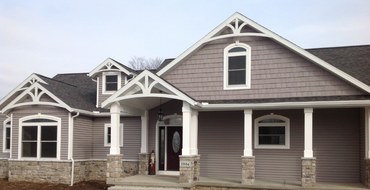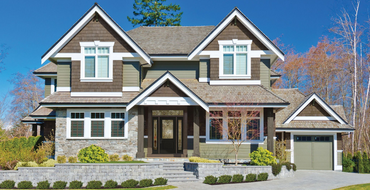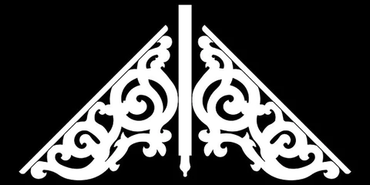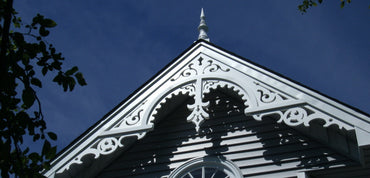Many homeowners, builders, and architects are familiar with gables, but don’t realize the storied history of the architectural feature, specifically how the gable wall, or pediment, was used to heighten exterior aesthetics and even tell legendary stories through sculpture.
While the ancient and medieval use of pediments have fallen to the wayside, the opportunity to make use of what are typically bare gables in modern building exteriors is a great opportunity for homeowners, builders, and even architects. In this article we’ll explore where gable pediments came from and the modern options available to the building world.

Gables and Pediments, Is There a Difference?
Before diving into the history of gable pediments, let’s take a second to talk about this often confusing terminology. Fundamentally, a gable is the triangular section located between the peak of two intersecting roof pitches. It’s found wherever two pitched rooflines intersect and may be adorned with architectural elements, modern styling, art, and even windows.

Gables are a familiar structure that is present on the exterior of many traditional home styles. The relative size and shape of gables are different, depending on the pitch of the roof. Steeper pitches are often used to mitigate snow buildup in more wintry climates, as well as churches and other buildings who rely on steep roofs to create high-ceilinged interiors. There exist architectural building styles that do not rely on pitched roofs and therefore do not have gables, but these are fairly rare for typical home building.
In the ancient world where building was rudimentary, the gable was a significant technological discovery as it allowed skilled tradesmen to create these pitched roofs. In time, they realized that the gable provided a wonderful canvas to create intricately designed, beautiful works of art to complement the building's exterior aesthetic, and so became the origination of the pediment.

A pediment is a gable decorated with elaborate sculptures or other artwork. In other words, all pediments are gables, but not all gables are pediments.
A Brief History of Pediments
You can find pediments in most ancient structures, including but not limited to, Greek, Baroque, Rococo, Roman, Renaissance, and Neo-classical architecture. The Parthenon is a beautiful example of a structure with a pediment at its finest.
Pediments were developed in Ancient Greece to create ornate gable ends on their temples. In Rome and other architectural revivals, they were commonly installed over windows and doors. As the great cathedral architects of Europe came into their own 100s of years later, with their soaring ceilings and steeply pitched roofs, they continued the tradition of heavily-decorated gable pediments. Some of the most revered architecture in all of human history, the gothic cathedrals of Europe, are adorned and studded with gable pediment decoration and artwork that visitors from all over the world still come to see to this day.

Gable Pediments in Modern Development
While the ancients certainly relied heavily on pediments for exterior aesthetics, and then medieval builders used them for both aesthetics and function, modern building let gable pediments fall to the wayside. For the last half century, the vast majority of homes built in North America rely on pitched roofs that frequently lend to gabled designs. The gables, however, are generally left unadorned, except for a standard cladded covering.
In recent years, exterior design trends have renewed interest in gable pediments to create a positive impact on curb appeal. Modern materials have further encouraged homeowners, builders, and architects to be inspired by gable pediments and use that triangular focal point to make a statement.
Modern Gable Pediments
At the time when pediments originated, they were mostly carved from stone or wood. As time went on, wood became more commonplace in residential applications as it’s easier and cheaper to work with than stone. For large projects with handsome budgets, you’ll still find intricate stone gable pediments, especially on neo-classical style buildings.
A great alternative material to stone and wood is PVC. PVC can be designed and painted to any specification, isn’t as heavy as wood and stone, and yet retains the durability of those classic materials.
Enhance the Style of Your Home’s Exterior with PVC Gable Pediments
Gable pediments elicit a sense of old-world wonder and offer homeowners an easy and affordable feature to finish crafting their home’s exterior look. Whether an elaborate gable pediment or a more minimalistic design, utilizing colors, in combinations with the roof and home trim, can create vivid contrast with the roof and walls.

There are a variety of types, styles and materials to consider for your gable pediment. However, there are many benefits that come with choosing PVC over the other material alternatives, including:
- Superior quality
- Increased durability
- UV- and moisture resistance
- Insect resistance
- Flame retardance
- No required painting or staining
- Low maintenance
- Affordable, visual impact
- Easy to install
- Unlimited customization
At PVC Millwork, we specialize in creating gorgeous gable pediments and other gable accessories with beauty, budget, and durability in mind. Enhance the style of your home’s exterior with our collection of over 40 gorgeous gable pediments designs, or contact us today if you’d like to explore your own design through our custom fabrication capabilities.




